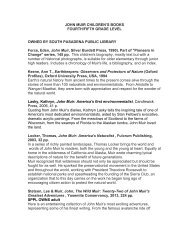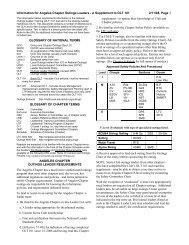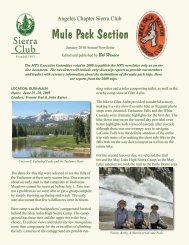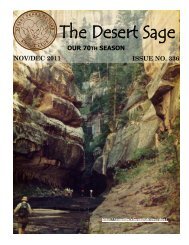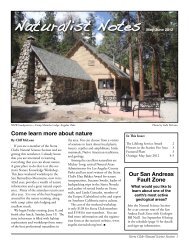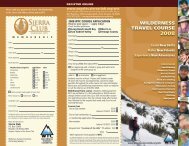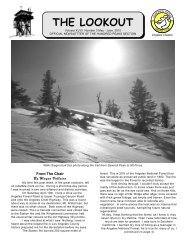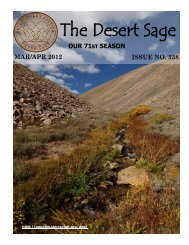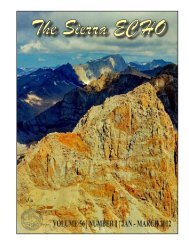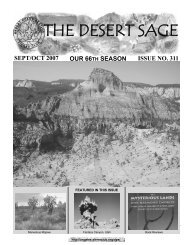The Sierra Echo - Sierra Club - Angeles Chapter
The Sierra Echo - Sierra Club - Angeles Chapter
The Sierra Echo - Sierra Club - Angeles Chapter
You also want an ePaper? Increase the reach of your titles
YUMPU automatically turns print PDFs into web optimized ePapers that Google loves.
Suffering from near-terminal jet lag, we spent the rest of<br />
the day napping at a local hotel.<br />
Next morning, a Saturday, we visited the market, which<br />
in my journal I described as, “(B)reathtaking. Hundreds,<br />
if not thousands, are crowded into the plaza selling their<br />
wares. <strong>The</strong> average Ecuadorian Indian is on the small<br />
side—very few more than 5’5”; many below 5’. <strong>The</strong><br />
men wear white pants and the women, with gold beads<br />
around their necks, wear long, dark dresses. Many<br />
women are barefoot, while most men wear their hair in<br />
a braid. All wear felt hats.”<br />
“Nearly all the goods sold at the market are made of<br />
wool—hats, gloves, sweaters, rugs, yarn, handbags,<br />
and decorative pieces. Foodstuffs (including a huge<br />
variety of potatoes) are sold in streets along the plaza’s<br />
periphery, and there is a great carnival atmosphere<br />
about the entire activity. <strong>The</strong> Indians seem friendly,<br />
soft-spoken and polite.”<br />
That afternoon we returned to Quito, where we had<br />
a dinner consisting of a gigantic 2 lb., $4.50 T-bone<br />
steak.<br />
After spending the next day, Sunday, touring Quito—<br />
population approximately 1.7 million—we departed<br />
Monday morning, January 10, for the spacious, two-story<br />
José Ribas hut, situated at 15,700’on the northern slopes<br />
of Cotopaxi. In my journal I wrote, “Unfortunately,<br />
our van, carrying seven passengers and all our luggage,<br />
doesn’t have enough power to make it all the way up<br />
the steep road to the hut. We off-load the passengers,<br />
after which, with a little pushing to help, Jorge manages<br />
to drive the luggage-filled van to the hut. We climbers<br />
follow on foot.”<br />
Cotopaxi is one of the highest active volcanoes in<br />
the world. Since 1738, the volcano has erupted<br />
more than 50 times, the resulting mudflows usually<br />
creating havoc below. Similar to Italy’s Mt. Etna and<br />
Washington’s Mt. Rainier, any future eruption could<br />
pose a huge risk to the local population.<br />
In 1802, Alexander von Humboldt became the first<br />
European to attempt to climb Cotopaxi. <strong>The</strong> first<br />
successful ascent, however, didn’t occur until Wilhelm<br />
Reiss, a German geologist, and his local guide, Ángel<br />
Escobar, accomplished the feat in November 1872.<br />
Tuesday, January 12, we arose at 1:30 a.m., downed a<br />
quick breakfast, and left the hut at 3:30 a.m. “<strong>The</strong> first<br />
leg of the climb is a steep 350’ section for which we<br />
rope up (we’re also equipped with crampons, ice axes<br />
and headlamps). We then wend our way a bit to the<br />
east through the heavily creavassed glacier. Later, as<br />
morning light begins to glow in the east, we drop our<br />
packs and traverse to the west under a large rock cliff.<br />
<strong>The</strong> final section is a steep climb in deep, wind-driven<br />
snow that gives way with each step. So that following<br />
climbers won’t have to create new footprints, we shorten<br />
the roped distance between each climber to 4 feet. As<br />
we near the rim we begin to smell the sulphurous fumes<br />
wafting up from the crater. We arrive at the summit at<br />
10:30 a.m., a seven hour ascent which Jorge tells us is<br />
about average.”<br />
<strong>The</strong> views from the top were impressive. Steve, Jim,<br />
Charlie and I were four happy climbers as the 19,000’+<br />
summit was our highest to date.<br />
On our descent we encountered a brief whiteout, and<br />
on the steep section just above the hut, we set up a<br />
stationary rope for a belay. That night at the hut I was<br />
so tired that I didn’t sleep well.<br />
Next day, January 13, after a late start, we drove south<br />
to La Ciénega, a magnificent 350 year-old estate—now<br />
a hostería—complete with dairy farm, stables, patios<br />
with Moorish fountains, and a chapel.<br />
We entered the grounds along a half-mile road lined<br />
with the largest, most beautiful ecualyptus trees I’d ever<br />
seen. That evening we relished grilled shrimp, vino<br />
blanco, and bananas in cream. Delicious.<br />
Because two of our climbers were under the weather the<br />
next morning, we decided to take the day off. To spend<br />
our time fruitfully, most of us drove into the small town<br />
of Saquisilí, where we spent the morning prowling<br />
through the local market. That afternoon we drove<br />
through small hillside farms to the rim overlooking<br />
Ecuador’s answer to Crater Lake, Laguna de Quilotoa.<br />
That evening we were the only guests at La Ciénega.<br />
Jan. 15, dawned clear and beautiful. “I spend so much<br />
time taking photos of Cotopaxi and nearby Illiniza Sur<br />
(17,218’), that I almost miss breakfast.”<br />
Leaving La Ciénega and driving south once more, we<br />
head, via Latacunga, for Ambato, a city of 200,000.<br />
<strong>The</strong> <strong>Sierra</strong> <strong>Echo</strong> 21



